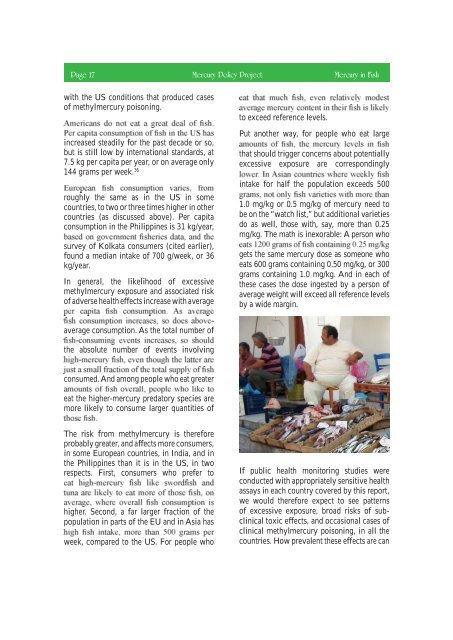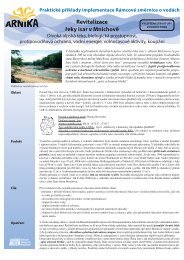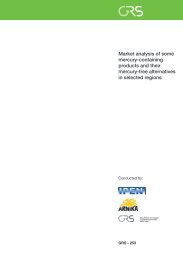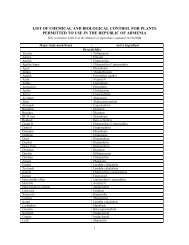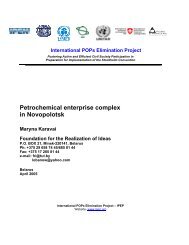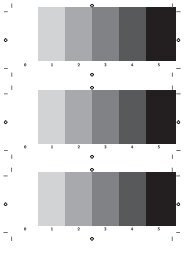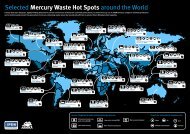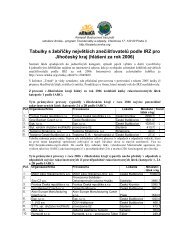Mercury in Fish 1.45 Mb - Arnika
Mercury in Fish 1.45 Mb - Arnika
Mercury in Fish 1.45 Mb - Arnika
Create successful ePaper yourself
Turn your PDF publications into a flip-book with our unique Google optimized e-Paper software.
Page 17 <strong>Mercury</strong> Policy Project<br />
<strong>Mercury</strong> <strong>in</strong> <strong>Fish</strong><br />
with the US conditions that produced cases<br />
of methylmercury poison<strong>in</strong>g.<br />
<strong>in</strong>creased steadily for the past decade or so,<br />
but is still low by <strong>in</strong>ternational standards, at<br />
7.5 kg per capita per year, or on average only<br />
144 grams per week. 36<br />
roughly the same as <strong>in</strong> the US <strong>in</strong> some<br />
countries, to two or three times higher <strong>in</strong> other<br />
countries (as discussed above). Per capita<br />
consumption <strong>in</strong> the Philipp<strong>in</strong>es is 31 kg/year,<br />
survey of Kolkata consumers (cited earlier),<br />
found a median <strong>in</strong>take of 700 g/week, or 36<br />
kg/year.<br />
In general, the likelihood of excessive<br />
methylmercury exposure and associated risk<br />
of adverse health effects <strong>in</strong>crease with average<br />
average consumption. As the total number of<br />
the absolute number of events <strong>in</strong>volv<strong>in</strong>g<br />
consumed. And among people who eat greater<br />
eat the higher-mercury predatory species are<br />
more likely to consume larger quantities of<br />
The risk from methylmercury is therefore<br />
probably greater, and affects more consumers,<br />
<strong>in</strong> some European countries, <strong>in</strong> India, and <strong>in</strong><br />
the Philipp<strong>in</strong>es than it is <strong>in</strong> the US, <strong>in</strong> two<br />
respects. First, consumers who prefer to<br />
higher. Second, a far larger fraction of the<br />
population <strong>in</strong> parts of the EU and <strong>in</strong> Asia has<br />
week, compared to the US. For people who<br />
to exceed reference levels.<br />
Put another way, for people who eat large<br />
that should trigger concerns about potentially<br />
excessive exposure are correspond<strong>in</strong>gly<br />
<strong>in</strong>take for half the population exceeds 500<br />
1.0 mg/kg or 0.5 mg/kg of mercury need to<br />
be on the “watch list,” but additional varieties<br />
do as well, those with, say, more than 0.25<br />
mg/kg. The math is <strong>in</strong>exorable: A person who<br />
gets the same mercury dose as someone who<br />
eats 600 grams conta<strong>in</strong><strong>in</strong>g 0.50 mg/kg, or 300<br />
grams conta<strong>in</strong><strong>in</strong>g 1.0 mg/kg. And <strong>in</strong> each of<br />
these cases the dose <strong>in</strong>gested by a person of<br />
average weight will exceed all reference levels<br />
by a wide marg<strong>in</strong>.<br />
If public health monitor<strong>in</strong>g studies were<br />
conducted with appropriately sensitive health<br />
assays <strong>in</strong> each country covered by this report,<br />
we would therefore expect to see patterns<br />
of excessive exposure, broad risks of subcl<strong>in</strong>ical<br />
toxic effects, and occasional cases of<br />
cl<strong>in</strong>ical methylmercury poison<strong>in</strong>g, <strong>in</strong> all the<br />
countries. How prevalent these effects are can


